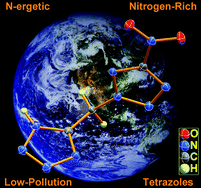Synthesis and properties of 5-nitrotetrazole derivatives as new energetic materials†
Abstract
An improved procedure for the synthesis of ![[1 with combining macron]](https://www.rsc.org/images/entities/char_0031_0304.gif) , ρ = 1.594 g cm−3) and 8 (monoclinic, P21/n, ρ = 1.633 g cm−3) were determined by low temperature
, ρ = 1.594 g cm−3) and 8 (monoclinic, P21/n, ρ = 1.633 g cm−3) were determined by low temperature

* Corresponding authors
a
Ludwig-Maximilians University of Muenchen, Institut fuer Anorganische Chemie, Butenandtstr. 5–13 (D), Munich, Germany
E-mail:
tmk@cup.uni-muenchen.de
Fax: +49 89 2180 77492
Tel: +49 89 2180 77491
An improved procedure for the synthesis of ![[1 with combining macron]](https://www.rsc.org/images/entities/char_0031_0304.gif) , ρ = 1.594 g cm−3) and 8 (monoclinic, P21/n, ρ = 1.633 g cm−3) were determined by low temperature
, ρ = 1.594 g cm−3) and 8 (monoclinic, P21/n, ρ = 1.633 g cm−3) were determined by low temperature

 Please wait while we load your content...
Something went wrong. Try again?
Please wait while we load your content...
Something went wrong. Try again?
T. M. Klapötke, C. Miró Sabaté and M. Rasp, J. Mater. Chem., 2009, 19, 2240 DOI: 10.1039/B818925K
To request permission to reproduce material from this article, please go to the Copyright Clearance Center request page.
If you are an author contributing to an RSC publication, you do not need to request permission provided correct acknowledgement is given.
If you are the author of this article, you do not need to request permission to reproduce figures and diagrams provided correct acknowledgement is given. If you want to reproduce the whole article in a third-party publication (excluding your thesis/dissertation for which permission is not required) please go to the Copyright Clearance Center request page.
Read more about how to correctly acknowledge RSC content.
 Fetching data from CrossRef.
Fetching data from CrossRef.
This may take some time to load.
Loading related content
